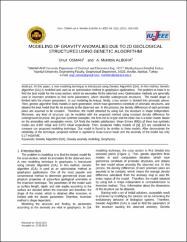| dc.contributor.author | Osman, Onur | en_US |
| dc.contributor.author | Albora, A. Muhittin | en_US |
| dc.date.accessioned | 2019-10-29T17:49:01Z | |
| dc.date.available | 2019-10-29T17:49:01Z | |
| dc.date.issued | 2015 | |
| dc.identifier.issn | 1303-0914 | |
| dc.identifier.uri | https://hdl.handle.net/20.500.12294/2041 | |
| dc.description | Osman, Onur (Arel Author) | en_US |
| dc.description.abstract | In this paper, a new modeling technique is introduced using Genetic Algorithm (GA). In this method, Genetic algorithm (GA) is modified and used as an optimization method in geophysics applications. The problem at hand is to find the best model for the cross-section, which its anomalies fit the observed ones. Optimization methods are generally used in inversion problems to find some parameters, which describe underground structures. The model shape is limited with the chosen parameters. In our modeling technique, firstly, cross section is divided into prismatic pieces. Then, genetic algorithm finds models in each generation, which have geometries constitute of prismatic structures, and obtains the best model that fits its anomaly to the observed one. In this process, the density differences of each prismatic piece are assumed to be constant. Therefore, the model obtained by using GA, the structure is shape independent. Moreover, any kind of structure can be modeled with the proposed method using constant density difference for underground structure. We give two synthetic examples; the first one is U type and the other one is a basin model. Based on the anomalies with acceptable errors, GA finds the models satisfactory. Mean Errors (MEs) of these two synthetic modes are 0.087 mGal and 0.073 mGal respectively. Then, Godavari Valley models of [1], [2] are considered to compare our proposed modeling technique. Our model is found to be similar to these models. After demonstrate the reliability of the technique, proposed method is applied to Sivas-Gurun basin and the anomaly of the model has only 0.17 mGal ME. | en_US |
| dc.language.iso | eng | en_US |
| dc.publisher | Istanbul University | en_US |
| dc.relation.ispartof | Istanbul University - Journal of Electrical and Electronics Engineering | en_US |
| dc.rights | info:eu-repo/semantics/openAccess | en_US |
| dc.subject | Genetic Algorithm (GA) | en_US |
| dc.subject | Geophysics | en_US |
| dc.subject | Gravity anomaly modeling | en_US |
| dc.title | Modeling of gravity anomalies due to 2D geological structures using Genetic algorithm | en_US |
| dc.type | article | en_US |
| dc.department | İstanbul Arel Üniversitesi, Mühendislik-Mimarlık Fakültesi, Elektrik-Elektronik Mühendisliği Bölümü | en_US |
| dc.identifier.volume | 15 | en_US |
| dc.identifier.issue | 2 | en_US |
| dc.identifier.startpage | 1929 | en_US |
| dc.identifier.endpage | 1935 | en_US |
| dc.relation.publicationcategory | Makale - Uluslararası Hakemli Dergi - Kurum Öğretim Elemanı | en_US |
| dc.department-temp | Osman, O., Istanbul Arel University, Department of Electrical and Electronics Eng., Buyukcekmece/Istanbul, 34537, Turkey; Albora, A.M., Istanbul University, Engineering Faculty, Geophysical Department, Avcilar, Istanbul, 34320, Turkey | en_US |


















